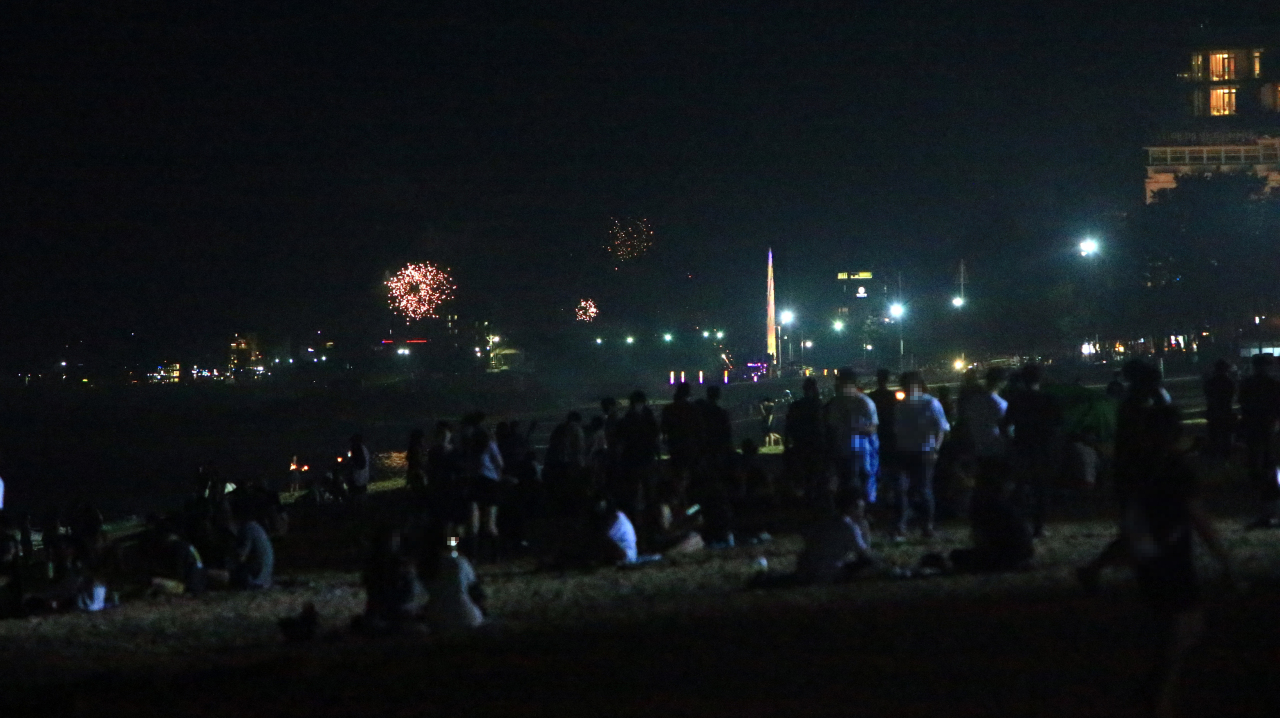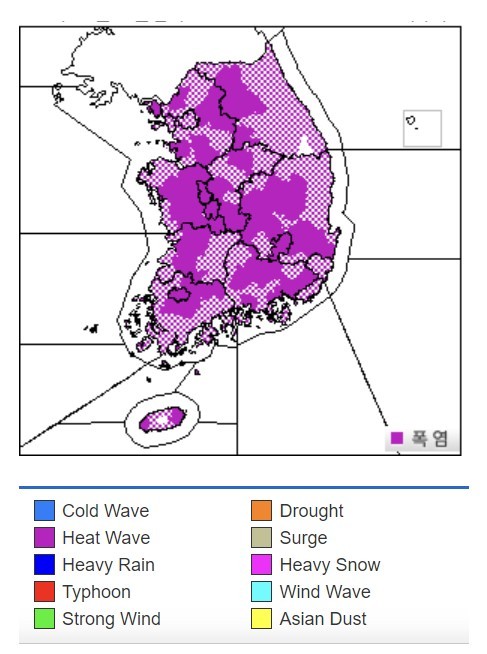Seoul records 1st 'tropical night' of year
More heat wave days, tropical nights observed in Korea during last decade, data show
By Kan Hyeong-wooPublished : July 13, 2021 - 14:06

Seoul recorded the year’s first “tropical night” from Monday evening through Tuesday morning, the Korea Meteorological Administration said Tuesday.
Usually observed during summertime in Korea, tropical nights are defined as when minimum temperatures hit 25 degrees Celsius or above after 6 p.m. and before 9 a.m.
According to the KMA, this year’s first tropical night in Seoul happened 23 days earlier than it did last year.
The sweaty nighttime phenomenon was also recorded in many other parts of the country on the same night, including Busan, Gwangju and Jeju Island.
“As the daytime temperatures recently continued to stay above 30 degrees Celsius with the atmosphere accumulating the warm air, the tropical night occurred with the increased temperatures not being able to cool down due to the cloudy weather at night,” the KMA explained.
As of 11 a.m. on Tuesday, the weather forecaster issued heat wave advisories for most parts of the country.
A heat wave advisory is issued when the daily maximum temperature is expected to top 33 degrees Celsius for two days in a row or longer. A more severe heat wave warning is issued when the figure is expected to exceed 35 degrees Celsius for two consecutive days or more.
Sizzling temperatures are forecast to continue until at least Thursday, the KMA said, with the heat index, or the “feels-like” temperatures likely to exceed 35 degrees Celsius in some southern and central inland regions due to the high humidity.
Usually observed during summertime in Korea, tropical nights are defined as when minimum temperatures hit 25 degrees Celsius or above after 6 p.m. and before 9 a.m.
According to the KMA, this year’s first tropical night in Seoul happened 23 days earlier than it did last year.
The sweaty nighttime phenomenon was also recorded in many other parts of the country on the same night, including Busan, Gwangju and Jeju Island.
“As the daytime temperatures recently continued to stay above 30 degrees Celsius with the atmosphere accumulating the warm air, the tropical night occurred with the increased temperatures not being able to cool down due to the cloudy weather at night,” the KMA explained.
As of 11 a.m. on Tuesday, the weather forecaster issued heat wave advisories for most parts of the country.
A heat wave advisory is issued when the daily maximum temperature is expected to top 33 degrees Celsius for two days in a row or longer. A more severe heat wave warning is issued when the figure is expected to exceed 35 degrees Celsius for two consecutive days or more.
Sizzling temperatures are forecast to continue until at least Thursday, the KMA said, with the heat index, or the “feels-like” temperatures likely to exceed 35 degrees Celsius in some southern and central inland regions due to the high humidity.

Scorching weather can continue for a long time if the North Pacific high pressure and Tibetan high pressure meet and create a heat dome -- the atmosphere trapping heat over a region like a lid on a pot -- on the Korean Peninsula, the weather agency said.
Korea’s record-breaking heat wave days all occurred due to the heat dome phenomenon. 2018 had the most number of heat wave days issued at 31.0, followed by 29.6 in 1994 and 22.0 in 2016.
The most severe weather disaster with the highest death toll on the Korean Peninsula was the heat wave in the summer of 1994 that killed over 3,300 people, according to the Heatwave Research Center. In 2018, there were over 4,500 people who reported heat-related illnesses.
Korea’s monsoon season, which usually runs between late June to August, has seemingly come to a halt after a seasonal rain front brought downpours to the southern parts of the country earlier this month.
While torrential showers will still come, the KMA said the upcoming heatwaves warranted more caution as hotter days are expected ahead.
“Unfortunately, there is a chance that we might experience something like the 2018 heat waves this year,” Woo Jin-kyu, an official from the KMA’s communication task force team, said in a press briefing Tuesday.
“The heat does not seem to be that weak (this summer). Special caution, in fact, is needed to prepare for the heat.”
More heat days and tropical nights have been observed in the country over the last decade, official data showed. There were an average of 14 heat wave days and nine tropical nights observed per year between 2011 and 2020, an increase of 3.9 and 3.3 days from the respective averages between 1973 and 2020.
The southeastern city of Daegu was the hottest place in the last three decades with the biggest number of average heat wave days per year at 27.6.
Seogwipo and Jeju City on the southern island of Jeju experienced the most number of tropical nights annually in the same period with 31 and 29.9 days, respectively.
By Kan Hyeong-woo (hwkan@heraldcorp.com)
Korea’s record-breaking heat wave days all occurred due to the heat dome phenomenon. 2018 had the most number of heat wave days issued at 31.0, followed by 29.6 in 1994 and 22.0 in 2016.
The most severe weather disaster with the highest death toll on the Korean Peninsula was the heat wave in the summer of 1994 that killed over 3,300 people, according to the Heatwave Research Center. In 2018, there were over 4,500 people who reported heat-related illnesses.
Korea’s monsoon season, which usually runs between late June to August, has seemingly come to a halt after a seasonal rain front brought downpours to the southern parts of the country earlier this month.
While torrential showers will still come, the KMA said the upcoming heatwaves warranted more caution as hotter days are expected ahead.
“Unfortunately, there is a chance that we might experience something like the 2018 heat waves this year,” Woo Jin-kyu, an official from the KMA’s communication task force team, said in a press briefing Tuesday.
“The heat does not seem to be that weak (this summer). Special caution, in fact, is needed to prepare for the heat.”
More heat days and tropical nights have been observed in the country over the last decade, official data showed. There were an average of 14 heat wave days and nine tropical nights observed per year between 2011 and 2020, an increase of 3.9 and 3.3 days from the respective averages between 1973 and 2020.
The southeastern city of Daegu was the hottest place in the last three decades with the biggest number of average heat wave days per year at 27.6.
Seogwipo and Jeju City on the southern island of Jeju experienced the most number of tropical nights annually in the same period with 31 and 29.9 days, respectively.
By Kan Hyeong-woo (hwkan@heraldcorp.com)


















![[KH Explains] Hyundai's full hybrid edge to pay off amid slow transition to pure EVs](http://res.heraldm.com/phpwas/restmb_idxmake.php?idx=652&simg=/content/image/2024/04/18/20240418050645_0.jpg&u=20240418181020)

![[Today’s K-pop] Zico drops snippet of collaboration with Jennie](http://res.heraldm.com/phpwas/restmb_idxmake.php?idx=642&simg=/content/image/2024/04/18/20240418050702_0.jpg&u=)